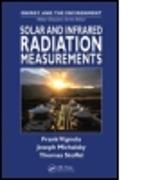Read more
Zusatztext "... fills a significant gap in the literature! providing updated information about the latest radiation measurement instrumentation and guidelines for its use. Another advantage of the new book is that it is structured as a textbook! including questions for the student at the end of each chapter! which increases its appeal beyond a reference for specialists."-Laura Hinkelman! PhD.! University of Washington"? provides the type of details needed for engineering a solar radiation monitoring system! including a history of devices used! detailed descriptions of the state-of-the-art devices! methods of calibration and uncertainty estimation! setup of a solar monitoring station! and manufacturers who can provide the equipment."-Frank Rytkonen! P.E.! Oregon Institute of Technology! Portland! USA"? the first comprehensive treatment of measurement and instrumentation of solar and infrared radiation. ? a well-organized approach to covering the topics including important concepts! physics principles! classical operational radiometry! state of the art technologies for solar and meteorological measurements! solar monitoring station! etc. ? examples are provided to help students learn the material. ? not only a suitable textbook for academic researchers and solar engineering students! but also an indispensable resource for solar systems engineers as well."-Prof. Xin Wang! PhD! Oregon Institute of Technology! Klamath Falls! USA Informationen zum Autor Frank Vignola is the director of the University of Oregon (UO) Solar Energy Center. He received his B.A. in physics at the University of California-Berkeley in 1967 and his Ph.D. in elementary particle physics at the UO in 1975. Deciding to apply his skills to more practical applications he started working in solar energy at the UO in 1977. Vignola helped establish and manage the UO solar radiation monitoring network that has the longest-running high-quality solar radiation data set in the United States. He has organized a number of solar resource assessment workshops and has written and contributed to approximately 100 papers in the field. He is currently an associate editor for solar resource assessment for the Solar Energy Journal.Joseph Michalsky is a physical scientist in the Earth System Research Laboratory within the National Oceanic and Atmospheric Administration (NOAA). Prior to NOAA he was with the Atmospheric Sciences Research Center at the State University of New York-Albany. He began his career at the Department of Energy's Pacific Northwest National Laboratory. Michalsky received his B.S. in physics at Lamar University and M.S. and Ph.D. in physics at the University of Kentucky. His early career focused on astronomical research before taking on problems in solar energy and the atmospheric sciences. Michalsky has nearly 100 refereed publications in these fields.Thomas Stoffel manages the Solar Resources and Forecasting Group at the National Renewable Energy Laboratory. He received his B.S. in aerospace engineering from the University of Colorado and M.S. in meteorology from the University of Utah. He began his career as an aerospace engineer at the U.S. Air Force Propulsion Laboratory simulating gas turbine engine performance and infrared radiation signatures. In 1978! Stoffel joined the Solar Energy Research Institute (now NREL)! where he developed the Solar Radiation Research Laboratory (SRRL) that continues to provide research-quality solar and infrared radiation measurements. Stoffel has more than 80 publications addressing solar resource characterization. Zusammenfassung The rather specialized field of solar and infrared radiation measurement has become more and more important in the face of growing demands by the renewable energy and climate change research communities for data that are more accurate and have increased temporal and spatial resolution. Updating decades of acquired knowledge in the field! Solar and ...

